Whether you choose to run on the West Side Highway or visit Equinox for your daily dose of exercise, I guarantee you will observe a variety of wearables — specifically “wristables” — on most people’s wrists. Between Apple Watches, Garmins, and Fitbits, no wrist remains untouched today.
But there is one particular wristable that has been quickly climbing up the ranks in the hierarchy of modern wearables, and that’s the WHOOP band.
This sporty bracelet isn’t just a fashion statement for people who are really (I mean, really) into optimizing every aspect of their health. It’s a fitness tracker that doubles down on the promise of improving physical performance through personalized data insights.
This focus was very intentional: with the wearable device market heating up, the purpose and use of the data they collect is the most important differentiator — and WHOOP decided to double down on quality data dedicated to improving athletic performance.
As it stands today, WHOOP is valued at $3.6 billion, with a quickly expanding user base. So, how did they swoop in and build a strong foundation in a space where Apple, Fitbit, or Nike used to dominate? Let’s take a closer look.
A Quick Stroll Down Memory Lane
WHOOP’s story starts in 2012. Will Ahmed, a young student athlete on the squash team at Harvard University, was actively looking to improve his health but felt like he was lacking the right data and insights to reach his peak performance.
Not unlike a lot of athletes, he struggled to strike a balance between training volume and recovery to achieve the best possible results. This personal experience of struggle is exactly what sparked his idea to develop WHOOP.
Ahmed enlisted two fellow Harvard students to bring his vision to life: John Capodilupo, who brought the software development expertise to the table, and Aurelian Nicolae, whose materials science experience could drive the hardware strategy. Together, they set out to build a wristable that took personal health insights beyond the conventional heart rate and step count measurement. Instead, WHOOP set out to focus on metrics that helped track recovery, strain, and sleep — the three pillars Ahmed considered foundational for performance improvements.
Developed by an athlete, for athletes, WHOOP stood out from competition thanks to its precise, targeted focus on a core audience persona. Unlike other wearables designed with casual users in mind, WHOOP was clearly designed for elite athletes who required precision in the insights they got.
This key differentiation set the tone for everything WHOOP’s marketing strategy would achieve in the years to come.
It’s important to also note how the timing of WHOOP’s emergence has contributed to the brand’s rapid growth.
For one, the global fitness tracker/wellness market has evolved steadily over the course of WHOOP’s lifespan, reaching $60.9B in valuation in 2024 alone. This number is projected to reach $192 billion by 2030, building on the growing public awareness of the value of health management and optimization. With the tech getting more advanced and the public focusing on mental and physical wellbeing increasingly more after the COVID-19 pandemic, wearable technology has seen exponentially increased demand and will continue to grow well into the next decade.
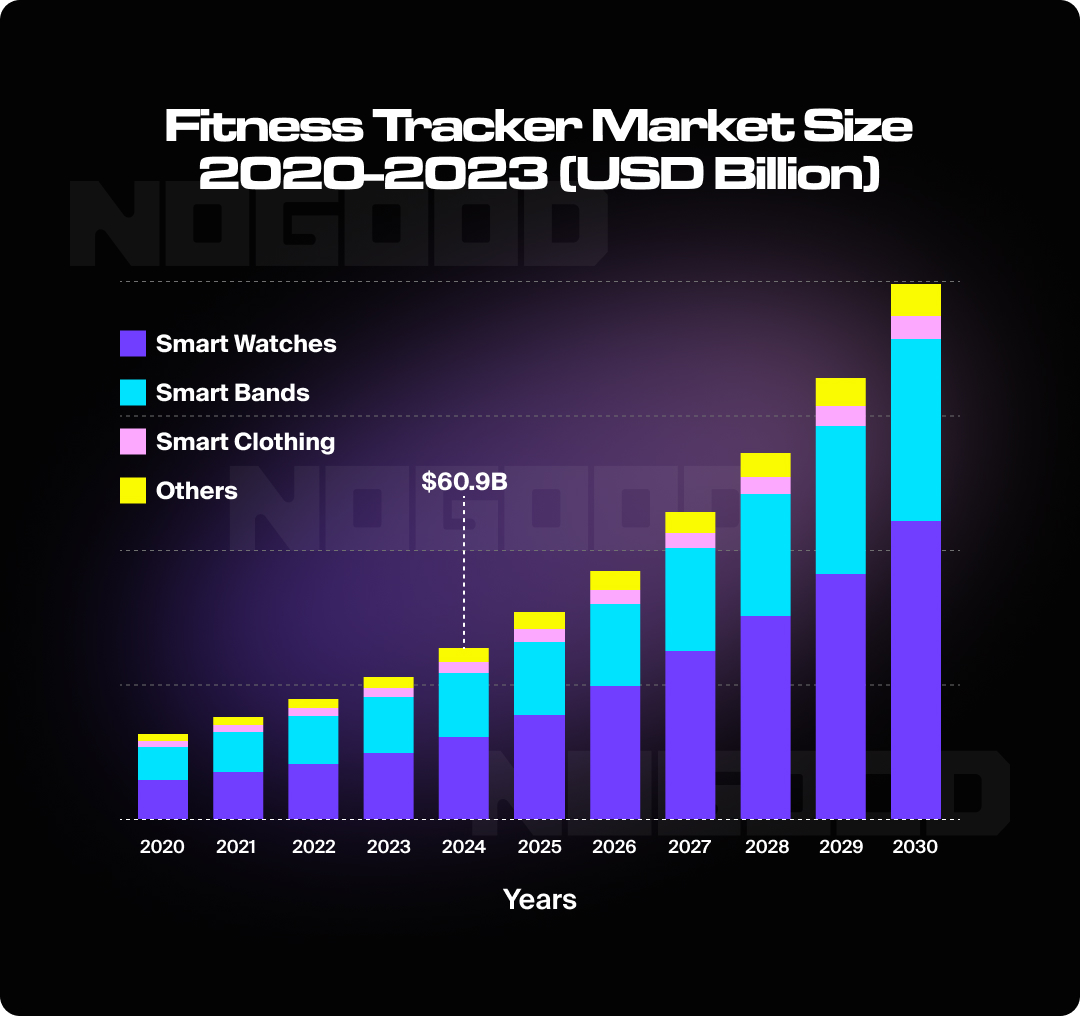
5 Marketing Strategies from WHOOP’s Playbook
If you look closely, WHOOP’s marketing strategy can be broken down into 5 key moves. Let’s explore the roles each of these intentional choices played in bringing WHOOP to the coveted “industry underdog” title.
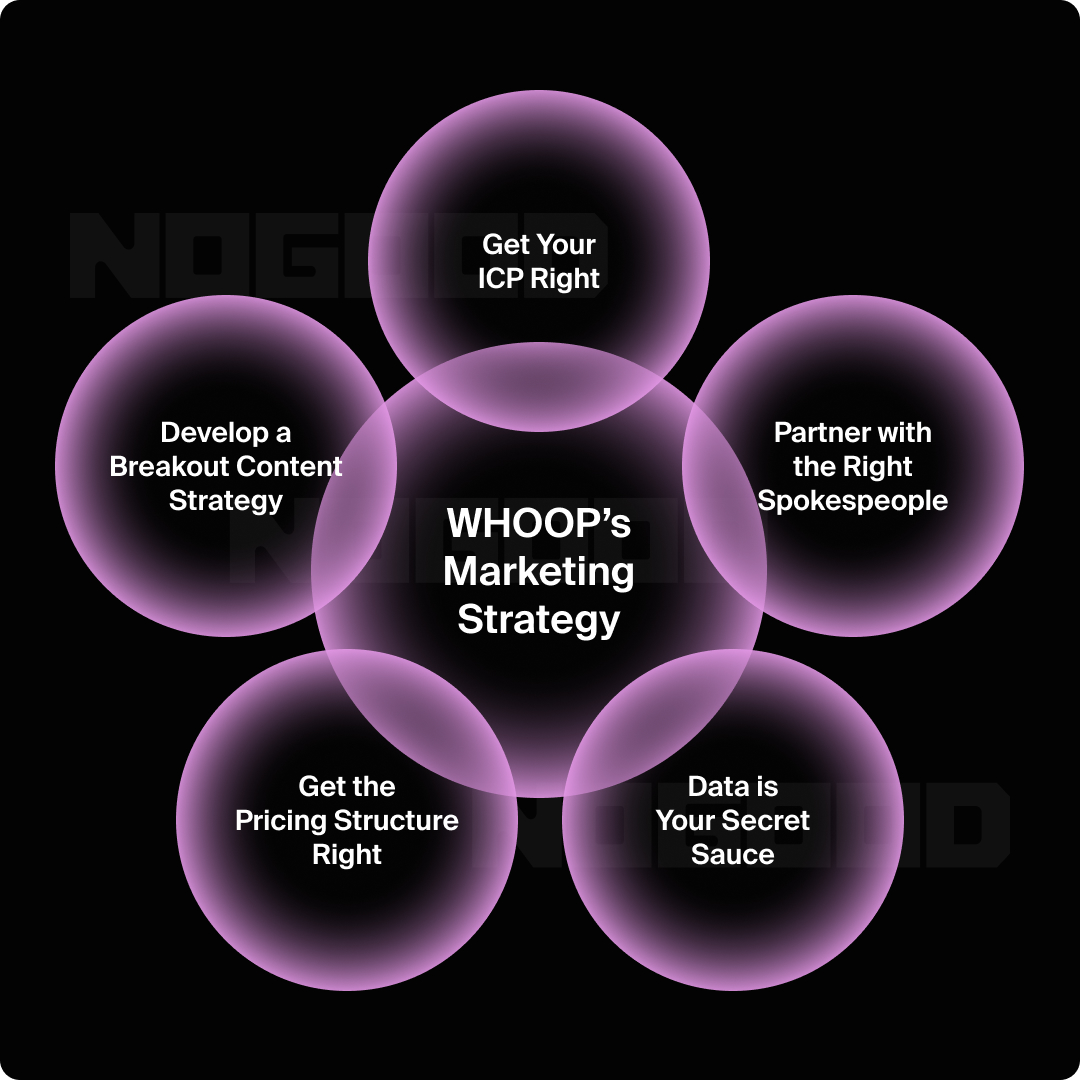
1. Get Specific on Your Ideal Customer Profile
If you couldn’t tell by the not-so-subtle foreshadowing earlier in this article, WHOOP cut through the noise in the wearable market by focusing on a very specific persona: the elite athlete. The brand’s strategy from day one has relied on the fact that the data the product provides is not average, and it’s okay if it’s not meant for the average consumer.
WHOOP successfully avoided the biggest trap most startups fall into within the first 5 years of operation — losing focus, attempting to solve for every need the consumer might have, and spreading themselves thin as a result.
However, an intentional decision like this also meant that for a young startup, it could come at a cost. Going after an athlete audience so early in their growth journey meant forgoing the resources to educate the non-athlete audience on the benefits and value of good sleep and recovery. Instead, they would focus on pro athletes who would crave any and all insights into their athletic performance — and this is where they were successfully able to stand up to bigger brands like Fitbit, Apple, or Nike that had expanded their reach to the mainstream consumer at that point.
Even though the move was risky, WHOOP did manage to build a community of power users ranging from Michael Phelps to Christiano Ronaldo.
2. Align Your Brand with the Right Spokespeople
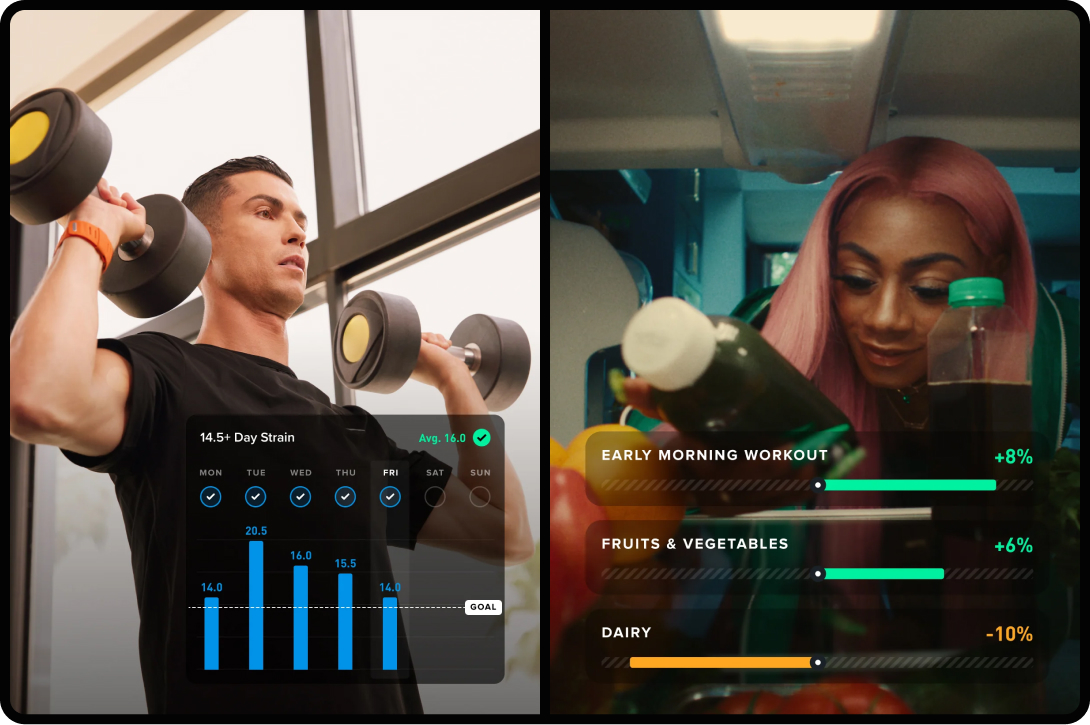
Now here’s the tricky part: if you choose elite athletes as your core audience, how do you partner with them on the record if they have exclusive contracts with the said legacy brands?
WHOOP played the long game here by zeroing in on delivering real value to star athletes and providing the exact insights they sought to improve their performance. Between 2012 and 2016, WHOOP worked on direct relationships with respected athletes, using the time to deepen their insights and quality of data — so much so that they successfully became the official wearables of record for MLB and NFL players, as well as the Navy SEALs.
WHOOP didn’t have to pay millions for official endorsements; the wearable easily got spotlight attention through media coverage of big-name players and athletes by simply becoming their indispensable wearable during training and on the court (or pitch, or ring, or pool…).
By showing up on the wrists of tier-1 players, WHOOP gained natural credibility without the promotional aid of official brand deals or ad campaigns. This set WHOOP up for success in 2015 when it officially became available to the public.
3. Develop a Breakout Content Strategy
WHOOP’s focus as a brand doesn’t just show up through the product they’ve created — it also drives the story they tell through their content strategy. The biggest lesson you can learn from WHOOP is to treat your brand as a media company, and produce and distribute content that covers a wide variety of platforms, formats, and strategies.
From its social media presence to its proprietary podcast, WHOOP clearly speaks to a performance-driven audience, and they speak as an authority in everything health optimization.
Their social media presence, for example, has very clear content pillars that showcase an editorial strategy that delivers value beyond the product:
- WHOOP = authority: from data-backed analyses of popular health trends to user data patterns, WHOOP educates the end consumer on better choices to reach their peak potential.
- WHOOP = credible: through owned and earned coverage, WHOOP populates major feeds with content that features familiar faces of athletes that have cult followings, from Christiano Ronaldo to Aryna Sabalenka.
- WHOOP = relatable: the brand also has a strong pulse on how their users interact with the product, expertly tapping into relatable scenarios and experiences that foster a sense of community and togetherness between customers.
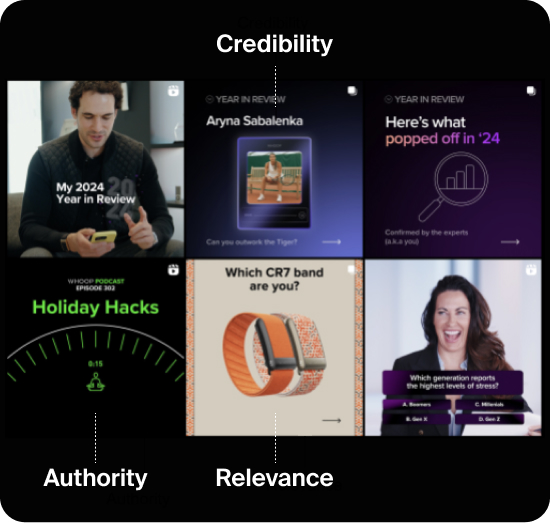
“The WHOOP Podcast,” which is also distributed in bite-sized cuts across their socials, takes deeper dives into the science behind strain, recovery, and stress. WHOOP is by no means a faceless brand: in addition to star guests on the WHOOP podcast and socials, Will Ahmed has also become an active participant in the brand’s content, sharing his own experiences, WHOOP’s story, and the team behind the product as well.
4. Data: The Secret Sauce
WHOOP’s magic offering has always been its data: in-depth insights, actionable recommendations, and personalized snapshots of performance. It’s this data-driven focus that landed them the first milestone relationships early in their growth journey; now, it’s a) the biggest selling point and b) a major pillar in their content strategy that showcases WHOOP in action.
If you take a close look at the brand’s content strategy, a large portion of their social content incorporates proprietary data stories that either translate interesting insights into captivating stories or provide educational (read: non-transactional) value to both WHOOP users and colder audiences.
This approach is strategic in many ways, but mainly because data is the currency that WHOOP trades in as a brand, and the Spotify Wrapped-esque approach to content generation allows for the granularity of WHOOP’s insights to speak for themselves.

The data stories the brand shares reflect the wide range of depth and timeliness WHOOP provides, from evergreen data insights and studies (e.g., how generations stack up) to trendy topic breakdowns (e.g., sober October).
5. Get the Pricing Structure Right
There are a few things about WHOOP’s pricing strategy that make the brand stand out from their competitors.
First and foremost, WHOOP provides the hardware for free in contrast to any other player in the market. The band is included in the membership purchase, but there is no additional cost for the hardware itself — which is unlike other wearables on the market.
The second factor here, as you’ve probably guessed, is WHOOP’s subscription-based model that they deliberately switched to in 2018. Unlike most wearables that rely on a one-time hardware purchase, WHOOP gives the hardware away for free and charges users a monthly subscription fee for access to its analytics platform.
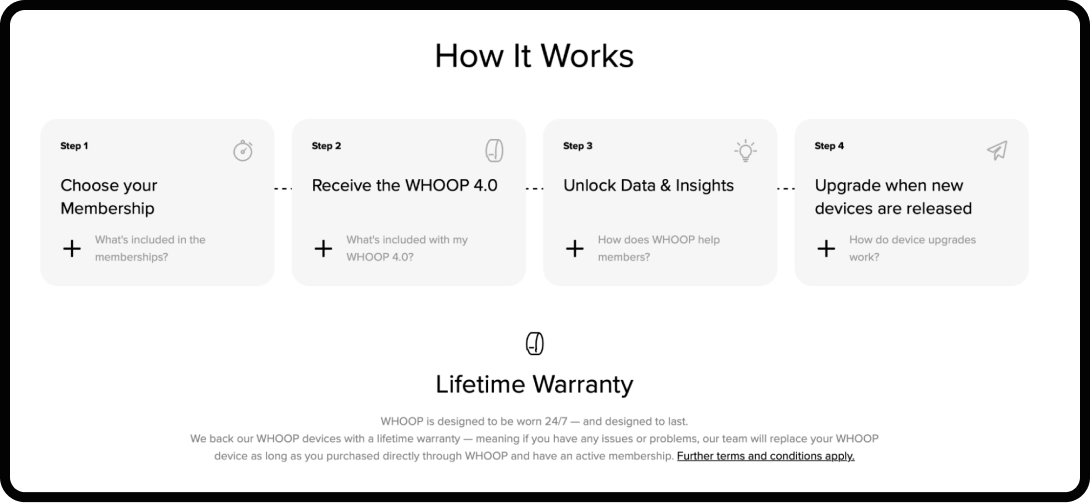
This standout approach has two major benefits.
First, WHOOP has lowered the barrier to entry for users who might hesitate to spend several hundred dollars on a fitness tracker from the get-go. It allows people to take advantage of what WHOOP has to offer without a heavy commitment cost upfront, making the product more sticky, the decision to join WHOOP easier, and the user LTV higher.
Second, it emphasizes WHOOP’s positioning as a data company first, and not a hardware company. WHOOP’s biggest advantage has always been the precision of its data — and for the performance-driven audience they focus on, the degree of data accuracy and depth is much more important than the hardware itself. In their own words, the team behind WHOOP believes the band should be “cool and invisible.”
The result is a more engaged community alongside a steady revenue stream.
Closing Thoughts
WHOOP is a strong contender to continue scaling and (potentially) dominating the wearables market — and the brand is still in its early stages of growth despite the major wins it has scored. As of 2022, the brand is more accessible through retail partnerships like Best Buy in the US; WHOOP has also introduced a B2B enterprise offering, diversifying their model beyond B2C.
Here’s a checklist of the key moves that have brought WHOOP so far over the last decade and will likely continue to drive the brand’s growth in the future.
- Niche down with your audience before scaling up → You can’t win if you try to be everything for everyone.
- Treat your business like a media company → Content is king, so make sure you create and distribute content consistent with your positioning.
- Align with the best to become the best → Be very intentional about who your power users will be.
- Think about non-transactional value → From your content to your product quality or pricing strategy, show that you care.






